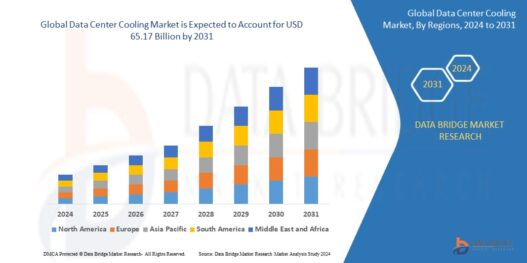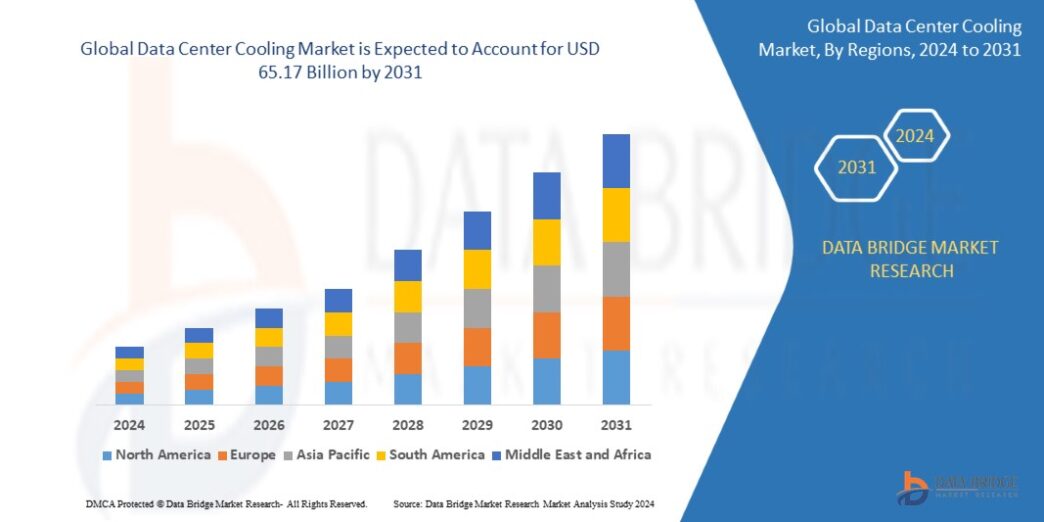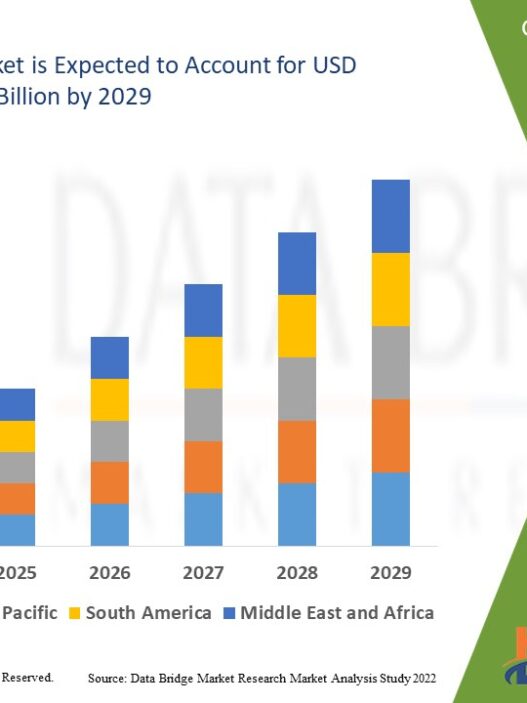Introduction
With the exponential growth of data usage and cloud computing, data centers have become the backbone of digital infrastructure. However, the vast amount of heat generated by servers, networking equipment, and storage devices necessitates efficient cooling solutions.
Data Center Cooling is crucial for maintaining optimal performance, preventing equipment failure, and reducing energy consumption. As the demand for data processing increases, the global data center cooling market is witnessing significant growth, driven by technological advancements, sustainability concerns, and the need for cost-effective cooling solutions.
This article explores the evolving landscape of data center cooling, market trends, technological innovations, and future growth opportunities.
Understanding Data Center Cooling
What is Data Center Cooling?
Data center cooling refers to the set of technologies and techniques used to regulate temperature and humidity levels within data centers. The primary goal is to prevent overheating, which can lead to system failures, downtime, and increased operational costs.
Key Cooling Requirements in Data Centers
- Maintaining an optimal temperature (typically 18-27°C)
- Managing airflow efficiently
- Reducing humidity fluctuations
- Ensuring energy efficiency to lower operational costs
Impact of Cooling on Data Center Performance
Efficient cooling enhances hardware longevity, improves system reliability, and contributes to overall sustainability efforts. With increasing energy demands, innovative cooling strategies are essential to maintaining operational efficiency while minimizing environmental impact.
Market Dynamics of Data Center Cooling
Current Market Trends
- Growing adoption of liquid cooling solutions
- Increased focus on energy-efficient cooling
- Rising popularity of modular data center cooling
- Expansion of edge computing data centers
Growth Drivers and Challenges
✔ Growth Drivers:
- Surge in cloud computing and big data analytics
- Rising demand for hyperscale data centers
- Government regulations promoting energy-efficient solutions
❌ Challenges:
- High installation and maintenance costs
- Complex cooling infrastructure requirements
- Environmental impact concerns
Impact of Increasing Data Center Demand
The rise of AI, 5G, IoT, and machine learning has significantly increased computing power requirements, leading to higher cooling demands. This has spurred innovations in efficient cooling technologies to keep up with the growing energy consumption.
Market Segmentation
By Type
- Air-Based Cooling – Uses air circulation and traditional HVAC systems
- Liquid-Based Cooling – Involves direct-to-chip or immersion cooling
- Hybrid Cooling – Combination of air and liquid cooling for optimized efficiency
By Component
- Cooling Units
- Chillers
- Economizers
- Cooling Towers
By End-User Industry
- IT & Telecom – Major users of data centers
- BFSI (Banking, Financial Services, and Insurance) – Growing need for secure data storage
- Healthcare – Demand for real-time data processing and AI integration
- Government & Defense – Large-scale computing power requirements
By Region
- North America – Market leader due to high concentration of data centers
- Europe – Growing focus on sustainable data centers
- Asia-Pacific – Rapid growth in cloud services and digital infrastructure
Key Players in the Data Center Cooling Market
Several companies are leading innovation in data center cooling, including:
- Schneider Electric – Specializes in energy-efficient cooling solutions
- Vertiv – Offers cutting-edge cooling systems for hyperscale data centers
- Rittal – Focuses on modular cooling technologies
- Stulz GmbH – Provides high-performance liquid cooling systems
Recent Developments and Investments
- Expansion of manufacturing facilities
- Strategic acquisitions and partnerships
- Increased funding for sustainable cooling solutions
Technological Advancements in Data Center Cooling
Liquid Cooling Technology
- Direct-to-chip cooling
- Immersion cooling for enhanced efficiency
- Reducing reliance on traditional air cooling methods
AI-Driven Cooling Optimization
- Predictive analytics for temperature management
- Automated cooling adjustments based on workload changes
Energy-Efficient Cooling Solutions
- Free cooling techniques utilizing external air
- Use of phase change materials (PCMs) for thermal energy storage
- Advancements in heat reuse technologies
Challenges and Barriers
High Energy Consumption and Costs
One of the primary challenges in the data center cooling market is the high energy consumption associated with traditional cooling methods. Cooling systems often account for 40-50% of a data center’s total energy usage, making it one of the most expensive operational aspects. Companies are actively seeking energy-efficient solutions to mitigate these costs.
Environmental Impact and Sustainability Concerns
- Traditional cooling systems rely on refrigerants that contribute to carbon emissions and global warming.
- Water-based cooling systems consume significant amounts of water, raising sustainability concerns in regions facing water shortages.
- The industry is shifting toward eco-friendly cooling technologies, such as liquid immersion cooling and AI-optimized cooling.
Regulatory and Compliance Challenges
- Governments worldwide are enforcing strict energy efficiency standards and carbon emission regulations for data centers.
- Compliance with ASHRAE (American Society of Heating, Refrigerating, and Air-Conditioning Engineers) standards is mandatory for many large-scale data centers.
- Companies must continually update their cooling infrastructure to meet evolving regulatory requirements, leading to increased capital expenditure.
Investment and Funding in Data Center Cooling
Major Investors and Funding Sources
The data center cooling market is attracting significant investment from:
✔ Tech Giants – Companies like Google, Microsoft, and Amazon are heavily investing in sustainable cooling solutions.
✔ Private Equity and Venture Capital Firms – Funding startups focused on innovative cooling technologies.
✔ Government Grants and Incentives – Supporting research into eco-friendly cooling methods.
Role of Government Initiatives and Policies
- Several countries have introduced green energy policies that encourage sustainable data center cooling.
- Tax incentives and rebates are being provided to companies adopting energy-efficient cooling technologies.
Future Investment Opportunities
- Expansion of hyperscale data centers
- Development of renewable energy-powered cooling solutions
- Increasing adoption of AI-driven cooling optimization
Emerging Trends in Data Center Cooling
Sustainable and Green Cooling Solutions
With growing environmental concerns, companies are focusing on:
- Liquid immersion cooling, which reduces energy and water consumption.
- Use of renewable energy sources such as wind and solar for cooling operations.
- Waste heat recovery systems, which repurpose excess heat for other industrial uses.
Adoption of Edge Computing and Its Impact on Cooling Needs
Edge computing is gaining traction, leading to the emergence of smaller, decentralized data centers closer to end-users. These micro data centers require compact and highly efficient cooling solutions, driving innovation in modular and liquid cooling technologies.
Growing Role of Hyperscale Data Centers
The rise of hyperscale data centers, operated by tech giants like Google, Amazon, and Facebook, is significantly impacting the cooling market. These facilities require advanced cooling strategies, such as:
- AI-powered thermal management
- Direct-to-chip liquid cooling
- Innovative airflow management techniques
Future Outlook and Market Predictions
Market Growth Projections for the Next Decade
The global data center cooling market is projected to grow at a CAGR of over 12% in the next decade, driven by:
- Increasing demand for cloud computing and big data analytics.
- Expansion of 5G networks, requiring efficient cooling for telecom data centers.
- Rising awareness of energy-efficient and green cooling solutions.
Impact of AI, IoT, and Cloud Computing on Cooling Demand
- AI-driven cooling systems can dynamically adjust cooling intensity based on real-time workloads, optimizing energy use.
- IoT sensors are being deployed to monitor and predict temperature fluctuations, reducing unnecessary energy consumption.
- Cloud computing growth is driving the need for larger and more efficient cooling infrastructures.
Innovations Expected to Shape the Industry
- Development of self-regulating cooling systems powered by AI.
- Advancements in cryogenic cooling for high-performance computing (HPC).
- Introduction of closed-loop water cooling systems to minimize waste.
Case Studies and Success Stories
Examples of Successful Cooling Implementations
- Google’s AI-Powered Cooling – Google implemented DeepMind AI to optimize cooling efficiency, reducing energy use by 40%.
- Microsoft’s Underwater Data Center – The company experimented with submerged data centers, using ocean water for natural cooling.
- Facebook’s Nordic Data Center – Located in Sweden, this facility uses natural air cooling, eliminating the need for traditional cooling methods.
Cost and Energy Savings Achieved
Companies adopting innovative cooling solutions have reported:
✔ Up to 50% reduction in cooling energy costs
✔ Lower maintenance and operational expenses
✔ Increased equipment lifespan due to optimized temperature control
Lessons Learned from Industry Leaders
- AI and machine learning can significantly enhance cooling efficiency.
- Natural and renewable cooling methods are effective in reducing environmental impact.
- Investing in modular and scalable cooling solutions can future-proof data center operations.
Competitive Landscape Analysis
SWOT Analysis of Key Market Players
| Strengths | Weaknesses | Opportunities | Threats |
|---|---|---|---|
| Advanced R&D in cooling technologies | High upfront costs | Growth of hyperscale data centers | Regulatory challenges |
| Strong global presence | Dependence on specific cooling methods | Expansion of AI-driven cooling | Competition from new entrants |
| Sustainable and energy-efficient solutions | Complex implementation process | Increasing government support for green cooling | Environmental concerns |
Market Share Analysis
- North America leads the market due to high adoption of cloud computing and big data analytics.
- Europe is witnessing growth due to stringent energy regulations.
- Asia-Pacific is fastest-growing, driven by rising data center investments in India, China, and Japan.
Strategies for Gaining a Competitive Edge
- Expanding R&D for next-generation cooling systems.
- Partnering with tech giants for AI-driven cooling solutions.
- Enhancing modular and scalable cooling infrastructure for diverse applications.
Role of Government and Regulatory Bodies
Environmental and Energy Efficiency Regulations
- Governments are pushing for energy-efficient data centers through policies like the EU Green Deal.
- The U.S. Department of Energy (DOE) is investing in sustainable cooling technologies.
Global Policies Affecting Data Center Cooling
- The Paris Agreement mandates carbon reduction, impacting data center cooling strategies.
- ASHRAE’s Thermal Guidelines regulate the acceptable temperature range for data centers.
Compliance Requirements and Industry Standards
- Companies must meet ISO 50001 energy management standards.
- LEED certification is becoming a benchmark for sustainable data center cooling.
Sustainability and Green Cooling Initiatives
Importance of Eco-Friendly Cooling Solutions
With increasing climate change concerns, data centers are focusing on:
✔ Carbon-neutral cooling strategies
✔ Use of natural and renewable cooling sources
✔ Recycling excess heat for nearby facilities
Innovations in Reducing Carbon Footprint
- Adoption of low-energy air cooling techniques
- Development of biodegradable cooling fluids
- Enhanced waste heat recovery systems
Corporate Sustainability Goals and Commitments
Tech giants like Amazon, Microsoft, and Google have pledged to operate carbon-free data centers by 2030.
Conclusion
The data center cooling market is undergoing rapid transformation, driven by technological innovations, sustainability initiatives, and increasing data processing demands. Companies are investing heavily in AI-driven cooling, liquid cooling solutions, and eco-friendly alternatives to tackle energy consumption and operational costs.
With the growth of cloud computing, 5G, IoT, and edge computing, the demand for efficient cooling solutions will continue to rise. The future of data center cooling lies in smart, adaptive, and sustainable technologies that ensure optimal performance while minimizing environmental impact.
Get More Details : https://www.databridgemarketresearch.com/reports/global-data-center-cooling-market










